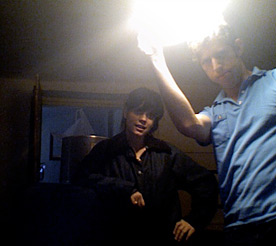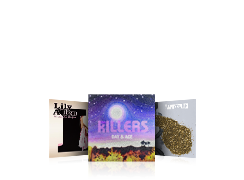
Greg Kurstin: Producing Lily Allen
If there’s any obvious downside to delivering a smash hit debut album, surely it’s the pressure to do it again. For Lily Allen, whose first album “Alright, Still” sold more than 2.5 million records, the pressure was enormous.
In 2006, a nearly unknown Lily Allen snuck up on her staggering debut success by releasing her songs on MySpace, incrementally building an army of “friends” whose rabid enthusiasm would drive both the creation and the consumption of the album. That album’s popular and critical reception, as well as Allen’s candid blogging about her music and her life, made her one of the world’s most recognized pop stars.
There would be no sneaking up, it seemed, on her much anticipated second album, “It’s Not Me, It’s You.” But Allen, running as usual against the grain, decided to try. Stepping temporarily out of London, where her life is followed as closely as the weather, she asked producer Greg Kurstin to join her for several sessions of remote songwriting in makeshift Logic-based “studios” set up in the English countryside.
Allen knew of course that no degree of geographical misdirection could improve her chances with her second album half as much as a fresh, strong musical direction. But she reckoned that in Kurstin — a former jazz keyboard prodigy and current Indie pop performer (with his acclaimed group, The Bird and the Bee) — she had a perfect partner for charting that new course.

For "It's Not Me, It's You," co-writers Allen and Kurstin looked for inspiration outside the studio. Photo credit: Greg Kurstin, via Photo Booth.
Not only did Kurstin bring significant Logic chops along with his platinum producing credits (Kylie Minogue, Britney Spears, Natasha Bedingfield), he was a known quantity, having co-written and produced three songs from Allen’s first album. Their established rapport put them, if not on the same page, at least on a familiar and possibly faster track to creating a voice and sound for the new album.
“There’s always that challenge of where to go from the first record,” says Kurstin. “You feel like you want to keep what people liked in the first place, but you want to take it somewhere else, too. I was just always running ideas through my head, even when I wasn’t working, to find original ones that could work for her and still keep everything in the style of Lily Allen.”
Writing in the Room
Allen says she sought out Kurstin in part because as a hands-on player/writer/producer he’s prolific at generating musical ideas “from scratch.” Kurstin confirms that he works best that way. “I prefer to write in the room, on the spot,” he says. “Just kind of write the song and do the track after. Also, Lily responds most creatively when I come up with things with her, as opposed to bringing in my concept of what I think she should do and her having to adapt to that,” he says.
“It also makes for less homework,” he adds, laughing. “I can just kind of leave it to the session, just figure it out.”
Real-time collaborative writing marked a significant difference from how he’d previously worked with Allen. “On the first record I’d come in with a developed track idea that I’d edit into a song,” says Kurstin. “But on this record, Lily didn’t write to tracks at all. Instead, I’d play ideas in the room on a Logic instrument, maybe two different simple piano chord progressions, like a motif. If she liked it, I’d just loop it around in Logic. When she’d come up with a verse, I’d listen to get an idea about how to develop the track. Then she’d lay down one or two vocals. After that I’d build up the track, which would inspire her to finish the song and write the chorus. It was sort of a tag team approach.”
Sonically Challenged
Because the early writing and recording sessions occurred in separate multi-week sessions in a rented Cotswold cottage, then in a country Manor House, Kurstin faced acoustic challenges as formidable as the creative ones. “It was a little tricky because these weren’t really sound-treated rooms but hard walls and stone, so sound was bouncing off of everything,” he says. “It was a challenge sonically, but that was OK, because the vibe was there.”
Kurstin temporarily converted both the cottage and the house into viable remote studios by renting microphones, speakers, and other necessary equipment and instruments. “Everything else was pretty much done on my laptop in Logic,” he says.
Guitars were recorded through a Neve/1176 directly into Logic. "I ended up using the Logic Guitar Amp Pro plug-in on all of the guitar tracks," he says. Vocals were recorded into Logic and produced using the Compressor, Channel EQ, Tape Delay, and Space Designer plug-ins that are part of Logic Studio.
Logical Choice
Kurstin, a lifelong Mac user who began using Logic in 2000 after seeing it in action in a studio session, says he favors an all-Logic workflow because it perfectly complements his writing style. “When I’m writing a song, I don’t want to take too much time fiddling with sound,” he says. “I just want to put up a few ideas, create something interesting or weird that might inspire us. Logic allows me to quickly build a track without losing creative momentum, so it was perfect for writing and recording in these countryside sessions.”
Mixing M.O.
In writing and recording “It’s Not Me, It’s You,” Kurstin worked in MIDI from beginning to end in nearly every track. “What I love about Logic is the way MIDI and audio live in the session side-by-side so seamlessly, because that’s really important for what I do, and it’s a great way for me to write.”
Kurstin stays with his software instrument and sampler tracks even in the final stages of mixing a track, leveraging Logic’s ability to handle his frequent late changes. “I'm changing tempos or adding punchier kick drums even in mixing. Logic makes it easy to do that.”
Custom Sounds
To stretch their basic electro-pop sound across songs that ranged from dancehall to jazz to 60s pop and even Country, Kurstin used Logic instruments and effects almost exclusively. Kurstin calls out Logic’s Compressor, Tape Delay, Guitar Amp Pro, and EQ as his workhorses in writing and producing the album.
For keyboards, Kurstin used lots of custom sounds that he’d sampled himself into Logic’s EXS24, including an upright piano, analog keyboards and organs, and vintage keyboards that he uses in his home studio.
“I liked having my own sampler, with my own sort of unusual, imperfect sounding samples,” he says. “I’ll just sample those in the laptop so I can have them while I travel, or sometimes I’ll just have my channel strips to write over. It was very useful to be able to just pull any of those out and instantly give an unfinished track a finished quality, so we could hear what it would really sound like.
“For synth stuff, I almost always used Logic’s ES2,” he says. I’m just so much quicker at getting what I want on ES2 than on anything else, and I always get the sound that I want. Using the random button, I found a really amazing screaming synth sound that I used both on “Everyone’s At It” and “Go Back to the Start.”
Kurstin also found useful the Evoc PS 20 Vocoder synth, which he used on several tracks including “Everyone’s At It,” “The Fear,” “Not Fair,” “Back to the Start,” “Chinese,” and “Who’d of Known.” “Frequently I’d play the chords of the chorus on the vocoder, sidechaining the lead vocal. I’d usually turn it way down, sometimes adding the guitar amp; it really helped make the chorus pop out.”
Back to the Top
Looking back, Kurstin believes his and Allen’s closely collaborative writing process helped them achieve precisely the something old, something new balance they were going for. “Musically it’s a bit different,” he says. “We don’t really reference the Jamaican Soul and Rock Steady that was on the first record, so it’s definitely a different sound from the original Lily singles. We were in a really creative mood, I think, and I love where Lily took it lyrically.”
Early indications are the public loves it, too. Even before “It’s Not Me, It’s You” dropped recently, its first released single, “The Fear,” was number one on the U.K Top 40 singles chart. And just days after the album was released, it was the number one downloaded album on iTunes.
“I’ve seen so many positive reviews, says Kurstin. “Even people who were expecting maybe to not like it admitted they like it. That’s always a surprise.”




